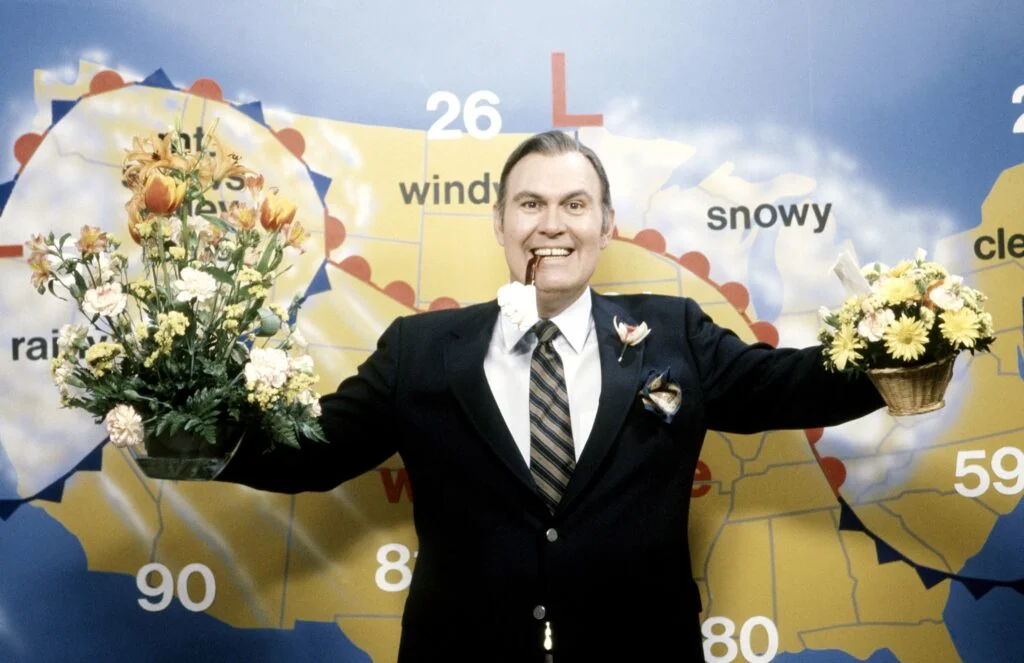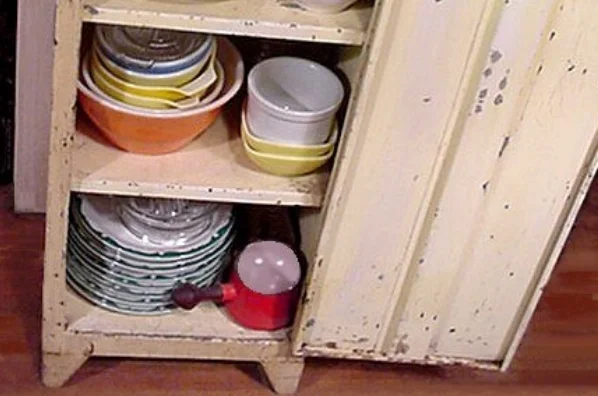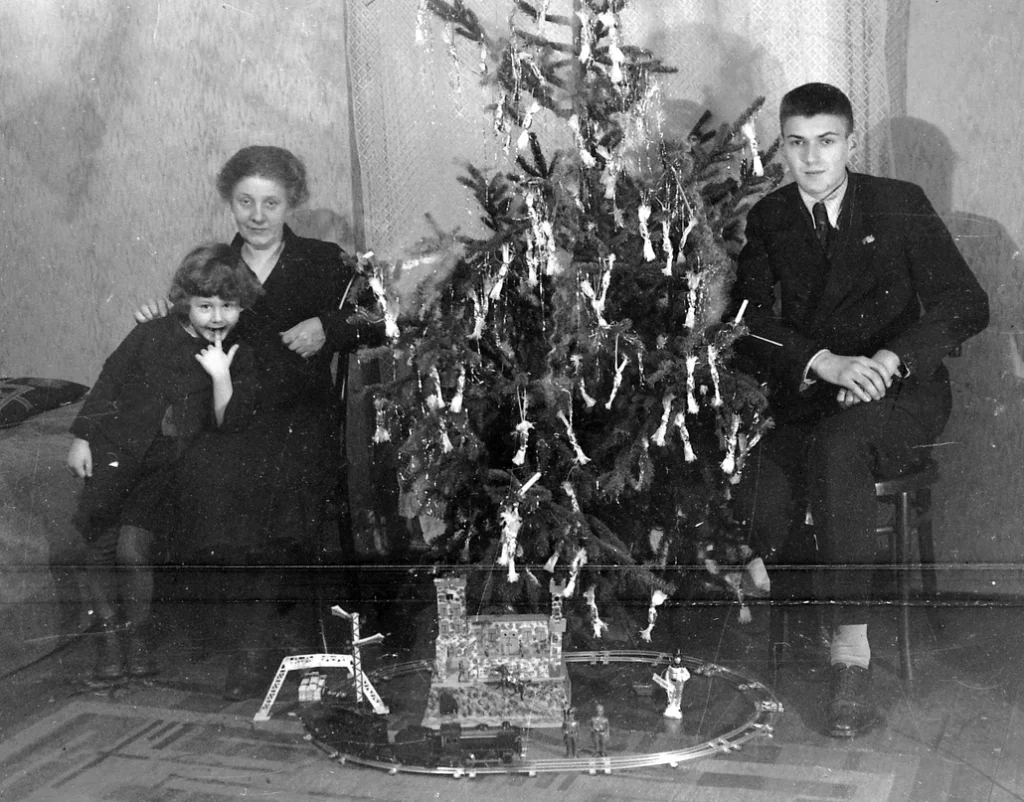Like echoes through time, our parents’ quirky habits and steadfast routines have a way of becoming our own. Whether it’s the peculiar way you fold your towels or your insistence on keeping the thermostat at precisely 68 degrees, these seemingly small behaviors are often carbon copies of what we grew up watching. As we get older, many of us experience that startling moment of recognition: “Good grief, I’ve turned into my mother/father!”
1. The Weather Report Ritual

Remember how Dad would religiously check the weather forecast each night, planning tomorrow’s activities around Mother Nature’s whims? Now you find yourself instinctively reaching for the remote after dinner, tuning in to the local meteorologist as if your day’s success hinges on their predictions. The weather app on your phone gets checked with the same frequency and intensity that your father once devoted to the evening news. This habit seems to transcend generations, as if believing we can somehow control the uncontrollable by simply being prepared for it. Perhaps this list of famous meteorologists on MeTV will also spark memories.
What started as an eye-rolling moment in your youth (“Dad’s watching the weather again!”) has morphed into your own non-negotiable evening routine. You catch yourself using the exact phrases your father once did—”Looks like we’re in for some weather tomorrow” or “Better bring a jacket, just in case.” Perhaps it’s less about the forecast itself and more about the comfort of routine, the small act of preparation that makes us feel like responsible adults in an unpredictable world.
2. The Coffee Cup Collection

Your mother’s cabinet always overflowed with mismatched coffee mugs, each with its own story or sentimental value. Now your own shelves groan under the weight of novelty mugs from vacations, gifts from colleagues, and that special one that feels just right in your hands on Sunday mornings. You’ve tried to purge them during spring cleaning, but something always stops you—the same something that prevented your mother from ever letting go of her collection. Each mug holds memories as much as coffee, becoming tiny time capsules of life’s journey. Recycling Today also notes that collecting mugs also presents boundless opportunities, from decorating to storage.
The ritual extends beyond mere collection to include how you prepare your morning brew. The specific amount of cream (never milk), the precise number of seconds the spoon circles the cup, even the way you cradle the mug with both hands on chilly mornings—all mirror-image behaviors of your parent. You never consciously decided to adopt these habits; they simply transferred to you through years of shared breakfasts and quiet kitchen moments. Now they’re so ingrained that your day feels off-kilter without this carefully choreographed coffee ritual.
3. The Grocery Store Strategy

If your mother had a battlefield strategy for conquering the supermarket, chances are you’ve inherited her tactical approach. You find yourself moving through the aisles in the exact same pattern, perhaps even clutching a handwritten list organized by store layout just as she did. The way you thump melons to test their ripeness, squeeze bread for freshness, or meticulously examine eggs before placing them in your cart—these weren’t taught in any classroom. Your shopping trips follow an almost identical timeline to your parent’s—early morning to avoid crowds or perhaps just before closing when produce might be discounted. The history of grocery stores as recounted by Groceteria shows just how eventful its growth has been over the years.
The similarities extend to your interactions with store employees, where you might catch yourself using your father’s exact phrase when asking for assistance or your mother’s polite-but-firm tone when requesting a raincheck. You recall how embarrassing it once seemed when your parent knew every cashier by name, yet now you find yourself exchanging pleasantries with the same familiar faces week after week. This inherited choreography of commerce connects you to your roots in surprising ways, reminding you that even the most mundane errands carry the imprint of family tradition.
4. The Specific Way of Loading the Dishwasher

That heated debate about the “correct” way to arrange dishes in the dishwasher? It turns out you’ve inherited your parent’s unwavering position on this domestic battleground. You find yourself rearranging items loaded by others, muttering the same phrases your mother or father once did: “That won’t get clean if you put it there” or “Bowls always go on the top rack, facing inward.” The methodical approach—glasses on the right, plates angled just so—isn’t random preference but a deeply ingrained pattern observed throughout childhood. This seemingly trivial household habit becomes almost sacred in its precision, a testament to the powerful influence of watching our parents manage their domains.
What’s fascinating is how emotionally invested we become in these inherited systems, defending them with the same vigor our parents once did. You might catch yourself giving the same exasperated sigh when discovering improperly loaded utensils or feeling the same satisfaction when closing the door on a perfectly arranged load. The familiar click of the dishwasher door followed by the comforting hum of water creates a sense of order in your home, just as it did in your childhood kitchen. Perhaps this isn’t merely about cleanliness but about preserving a small piece of family culture—a domestic ritual passed down with all the reverence of a cherished recipe.
5. The Bedmaking Protocol

Morning hasn’t truly begun until the bed is made—a sentiment drilled into many of us by parents who wouldn’t dream of leaving the house with rumpled sheets. You might have resisted as a teenager, but now you find yourself automatically smoothing blankets and arranging pillows according to your parent’s exacting standards. The specific folding technique for the top sheet, the precise height of pillows, even the decorative arrangement of throw cushions follows patterns established decades ago in your childhood home. This daily ritual has become so automatic that an unmade bed creates a subtle discomfort, a feeling that something fundamental remains unfinished.
The timing of this ritual often mirrors your parent’s habits as well—perhaps immediately upon rising or after breakfast but always before the day officially begins. You might even hear your mother’s voice in your head as you tuck in that final corner or your father’s practical wisdom about starting the day with one accomplished task. What once felt like an arbitrary rule has transformed into a moment of mindfulness in your adult routine, a brief pause before facing the day. This simple act connects you to previous generations through muscle memory and shared values about order and care.
6. The Peculiar Pantry Organization

That unshakable conviction about where canned goods belong versus dry pasta or the strict categorical system for spice organization didn’t emerge from thin air. Your pantry reveals ancestral patterns in how you group, stack, and arrange everything from cereal boxes to baking supplies. You might insist labels face forward just as your mother did or alphabetize condiments like your father, habits so deeply ingrained they feel like personal preference rather than inherited behavior. When someone misplaces an item, you correct it with the same mild frustration your parent once exhibited, protecting an organizational system whose origins predate your own household.
The emotional security provided by this familiar arrangement extends beyond mere efficiency. There’s comfort in reaching for the flour exactly where it’s “supposed” to be, just as it was in your childhood home. The way you stock emergency supplies, perhaps keeping extra cans of soup “just in case” or maintaining what seems like an excessive number of paper towel rolls, often replicates your parents’ approach to household management. These pantry habits serve as physical manifestations of values around preparation, abundance, or frugality that were silently transmitted across generations. Your grocery shopping list may even follow the same unspoken rules about what constitutes “running low” on essentials.
7. The Driving Quirks

Behind the wheel, your parent’s influence emerges in surprising ways—from how tightly you grip the steering wheel to your specific parking preferences. Perhaps you’ve inherited your father’s habit of arriving everywhere fifteen minutes early or your mother’s insistence on backing into parking spaces. You might find yourself automatically turning down the radio when approaching an unfamiliar intersection or using identical phrases when commenting on other drivers’ behaviors. These driving patterns feel natural and logical but are often perfect replicas of what you observed from the backseat as a child.
The maintenance routines follow familiar patterns too—checking tire pressure at the same intervals your parent did or feeling anxious when the gas gauge dips below quarter-tank. You might schedule oil changes with the same religious regularity or keep the same emergency supplies in your trunk. Even your reaction to traffic mirrors your parent’s approach—whether that’s patient acceptance, strategic route-finding, or colorful commentary delivered in eerily familiar tones. These automotive habits connect to deeper values about responsibility, preparation, and respect for machinery that traveled across generations along with the car keys.
8. The Furniture Arrangement Philosophy

The specific way you position your sofa in relation to windows or how you insist on balanced lamp placement likely echoes your childhood home’s layout. Without consciously deciding, you’ve adopted your parent’s rules about furniture—perhaps never placing it against certain walls, maintaining specific pathways, or arranging seating to facilitate conversation. These spatial preferences feel innate but actually reflect hundreds of subtle observations absorbed during formative years. You might even find yourself repositioning objects moved by others, restoring an order whose rules you can’t articulate but instinctively enforce.
Your response to visitors who disrupt this careful arrangement reveals the emotional investment in these inherited patterns. The slight discomfort when someone moves a chair or the satisfaction when rooms “flow” according to family tradition shows how deeply these spatial relationships matter. Perhaps most telling is the moment of recognition when visiting a sibling’s home and discovering they’ve arranged their living space with the same invisible blueprint. This shared spatial language becomes a silent connection to family identity, a three-dimensional expression of values around hospitality, functionality, and aesthetic harmony passed down through generations.
9. The Laundry System

From sorting techniques to folding methods, your laundry routine likely bears your parent’s unmistakable signature. You might separate whites and colors with the same zealous attention your mother demonstrated or fold T-shirts using the precise technique your father perfected. The timing follows familiar patterns too—perhaps Sunday afternoons are automatically laundry days or you feel oddly uncomfortable letting the hamper fill beyond a certain point. These habits weren’t formally taught but absorbed through observation and participation, becoming second nature over time.
The sensory aspects of this ritual often carry powerful emotional connections—the specific detergent scent that means “clean” to you or the satisfaction of precisely folded towels stacked on bathroom shelves. Your approach to hanging versus folding, the acceptable lifespan of a garment before retirement, even your attitude toward ironing often replicates patterns established in your childhood home. These textile traditions connect to deeper values around presentation, conservation, or domestic standards that traveled across generations in the laundry basket. When you find yourself smoothing wrinkles from pillowcases with the same careful attention your grandmother once showed, you’re participating in a domestic lineage older than you realize.
10. The Dinner Table Rules

Whether spoken or unspoken, the protocols governing mealtime in your home likely mirror those from your childhood table. You might find yourself automatically using your parent’s phrases to call family to dinner or feeling oddly uncomfortable if someone sits in what was “Dad’s chair” in your childhood home. The serving sequence, whether family-style or plated in the kitchen, typically follows the pattern established in your formative years. These dining rituals create a sense of continuity and belonging, connecting your current household to previous generations through the simple act of breaking bread together.
The conversational patterns reveal even deeper connections—perhaps electronics are banned just as they were (or would have been) in your childhood home, or you’ve inherited specific topics considered appropriate or inappropriate for dinner discussion. You might catch yourself enforcing table manners with your parent’s exact phrasing or feeling the same satisfaction when gathering everyone around the table despite busy schedules. These mealtime traditions transcend mere etiquette, embodying values around family cohesion, respect, and the importance of shared experience. The rhythms of passing dishes, waiting for everyone to be served before beginning, or lingering at the table after the meal connect your family table to an ancestral legacy of communion and care.
11. The Holiday Traditions

The holiday rituals you now consider essential likely began generations before you were born. You might find yourself recreating your mother’s precise Christmas cookie recipe lineup or insisting on the traditional Thanksgiving menu despite changing tastes. The timing of decorations going up and coming down, the specific ornaments that must appear on the tree, even the gift-wrapping aesthetic often mirrors what you experienced as a child. These seasonal patterns create a comforting continuity, connecting your current celebrations to the emotional memory of holidays past.
What’s remarkable is how these inherited traditions often overcome practical considerations or personal preference. You might maintain your father’s elaborate outdoor lighting display despite your own simpler aesthetic or continue making Aunt Martha’s fruitcake that nobody actually enjoys eating. The ceremonial aspects—who places the star on the tree, when presents are opened, which music accompanies meal preparation—follow scripts established long ago. These holiday habits form a living timeline connecting generations, creating a sense of belonging and continuity that transcends the individual. When you hear yourself saying, “It wouldn’t be Christmas without…” you’re echoing sentiments that have reverberated through your family for decades.
12. The Money Management Approach

Your attitude toward spending, saving, and discussing financial matters bears the unmistakable imprint of your upbringing. If your parents clipped coupons religiously, you likely find yourself instinctively scanning for deals or feeling slightly guilty about paying full price. The specific categories where spending feels justified versus frivolous often match your parents’ value system rather than your current financial reality. These money habits run deeper than practical considerations, reflecting inherited beliefs about security, success, and responsibility that shaped your childhood environment.
The emotional relationship with money reveals even stronger connections—perhaps you share your mother’s anxiety about unexpected expenses or your father’s pride in maintaining a spotless credit record. You might find yourself automatically using their phrases when discussing finances with your own children or partner: “Money doesn’t grow on trees” or “It’s not what you make but what you save.” The specific systems—whether maintaining a detailed budget, establishing emergency funds, or approaches to charitable giving—often replicate patterns observed during formative years. These financial philosophies connect to deeper values around security, generosity, and foresight that traveled across generations alongside the practical advice about balancing checkbooks.
As we recognize these inherited habits in ourselves, there’s a bittersweet revelation—we’ve become living archives of family culture, preserving traditions and values through everyday actions. Some habits we cherish and consciously maintain, while others we might choose to modify as we create our own family legacies. Either way, these behaviors connect us to our roots, reminding us that we’re part of something larger than ourselves—a continuum of lived experience passed from one generation to the next through the simple power of daily example.


